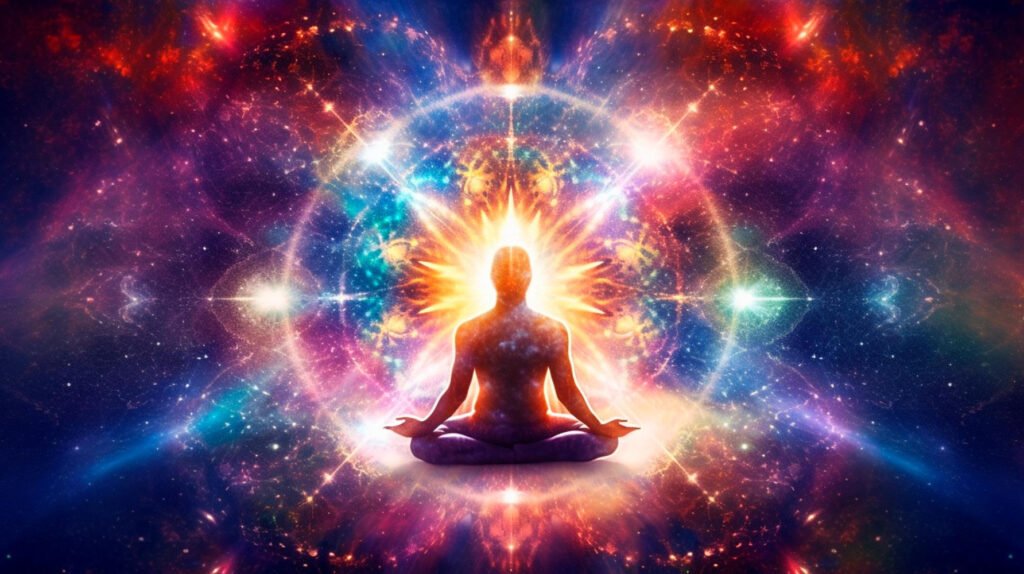Dive into this article because it reveals intriguing connections between meditation and hypnosis, offering fresh insights into these profound practices.
Meditation and hypnosis, two seemingly different practices, share a surprising amount of common ground. Both techniques involve entering a state of deep relaxation and focused attention, often with the aim of self-improvement or transformation.
Whether you’re meditating on a mountaintop or undergoing hypnosis in a therapist’s office, both practices tap into the power of the subconscious mind to promote healing, growth, and change.
This article delves into the similarities and differences between these two practices, offering insights into how they work and how they can be used to enhance your life.
So, if you’re interested in exploring the shared terrain of meditation and hypnosis, read on for a comprehensive understanding.
Key takeaways:
- Both meditation and hypnosis involve deep concentration and voluntary control.
- They induce a trance-like state for relaxation and healing.
- Guided sessions and relaxation techniques are commonly used in both practices.
- Mindfulness plays a crucial role in both meditation and hypnosis.
- Both practices have therapeutic benefits and promote mental well-being.
Commonalities Between Meditation and Hypnosis

Both practices hone in on achieving a heightened state of awareness, leading individuals to a journey inward to explore the realms of their minds.
1. Deep Concentration: Meditation and hypnosis both originate from a state of intense focus, directing attention inward, often facilitated by many techniques such as focusing on your breathing, an object, or a hypnotist’s words.
2. Voluntary Control: Both require an individual’s consent and active engagement. They are self-regulated practices where the participants are in control of their experiences.
3. Trance State: Frequently, they induce a trance-like state where the individual is neither fully awake nor entirely asleep, creating a unique bridge between levels of consciousness.
4. Guided Sessions: Both can be performed independently or guided by an expert. During guided sessions, instructions are shared either live or via audio recordings to support the steps involved.
5. Relaxation: Meditation and hypnosis share a common goal – promoting relaxation and counteracting the effects of stress on the person’s mind and body.
6. Therapeutic Benefits: Interestingly, both these practices are being widely used as complement therapies in healthcare due to their potential positive impact on mental wellbeing.
The Role of Mindfulness in Meditation and Hypnosis

Mindfulness, integral to both practices, improves self-awareness and shifts focus internally. In meditation, it helps maintain an impartial viewpoint towards thoughts or sensations. Hypnosis uses this increased self-awareness to effect positive changes in behavioral patterns.
Here are few key points to understand this concept better:
- 1. Both meditation and hypnosis employ mindfulness techniques to settle the unexpected flurry of thoughts and emotions. This helps to clear the mental clutter, resulting in a calm mind.
- 2. Mindfulness facilitates a deeper understanding of self in both practices, enabling recognition of repeated patterns and triggers.
- 3. This same mindfulness also aids hypnosis by amplifying the individual’s receptive capacity, allowing for effective implementation of suggestions.
- 4. In meditation, mindfulness encourages acceptance and non-judgmental observation, offering a fresh perspective towards various mental and physical experiences.
Remember, mindfulness is not just a transient state attained during these practices but can be integrated into daily life for amplified peace and balance.
Understanding Deep Relaxation in Both Hypnosis and Meditation

Deep relaxation is a profound aspect of both methods. Both techniques embrace it to promote a state of heightened awareness. During this phase, your body relaxes completely, and your mind becomes more open to positive suggestions, influences, and cues.
1. Mind-Body Connection: It refers to the interaction between your mind and body during the deep relaxation phase. This state is attained when your mental chatter diminishes, effectively calming your body’s stress responses.
2. Heightened Awareness: Deep relaxation allows you to bypass your conscious mind’s barriers. It enhances your receptivity, making you more attentive and open to your environment or thoughts.
3. Slower Brainwaves: During deep relaxation, brainwave patterns slow down. Theta waves, associated with deep meditation and sleep, become prominent in this state.
4. Control Over Physical Responses: In this state of relaxation, you can effectively control physical responses, like heart rate and blood pressure — helpful in stress management.
5. Openness to Positive Suggestions: Once in a state of deep relaxation, your mind becomes more accepting of positive thoughts and suggestions, lending to self-improvement and inner healing.
This phenomenon makes deep relaxation a crucial aspect of meditation and hypnosis, as it acts as the bridge bringing together the conscious and subconscious mind.
Altered States of Consciousness: A Shared Aspect of Meditation and Hypnosis

Both meditation and hypnosis rest on the premise of shifting one’s normal state of consciousness to an altered state. This state is characterized by heightened focus and concentration, often paired with reduced peripheral awareness.
In this altered state, individuals become more receptible to suggestion, a common feature in both practices. Hypnosis utilizes this openness and focus to implant ideas or behaviors, often for therapeutic purposes. Meanwhile, meditation leverages this state to foster introspection, increased self-awareness and a deeper understanding of the self.
Another parallel is that during an altered state, both practices encourage the release of daily distractions, stressors, and invasive thoughts. This allows for a more harmonious internal environment, offering the space for deep mental rest.
Lastly, it’s worth noting that these transitions into altered states of consciousness can be achieved through various techniques, from guided imagery and progressive relaxation in hypnosis to breath control and body scans in meditation. Although the techniques may differ, the shared objective remains to bring about this shift in consciousness.
The Benefits of Employing Meditation and Hypnosis

Diving into the advantages, it’s evident that these practices can significantly ameliorate stress levels. Meditation is renowned for reducing anxiety and churning out a sense of tranquility, while hypnosis often targets specific issues like phobias or habits, such as smoking, providing relief.
Another key benefit includes the enhancement of self-awareness. Both approaches promote a clearer understanding of one’s thoughts and emotions, leading to healthier emotional stability and improved mental agility.
Physical wellness can also be fostered using these tools. They can assist in pain management and reinforce the immune response by decreasing stress hormones in the body. More energy, better sleep quality, and heightened athletic performance are other notable perks.
Furthermore, both practices aid in cultivating positivity. By diminishing negative self-talk and encouraging a hopeful outlook, they can elevate mood and bolster self-confidence. This fosters personal growth and nurtures resilience to bounce back from life’s setbacks quicker.
Lastly, they are valuable tools for fostering creativity and enhancing memory. As they tap into the subconscious mind, new ideas flow freely, problem-solving abilities improve, and recall becomes more potent.
Practical Techniques in Meditation and Hypnosis

Donning the right posture is crucial. In meditation, this often involves sitting upright, comfortably, with a straight spine. During hypnosis, there are no strict guidelines, but comfort is equally important, possibly lying down or reclining.
The use of focus points is common to both. For instance, focusing one’s attention on breathing patterns is a common practice in meditation. Similarly, hypnosis may also involve focusing on an external item or maybe a practitioner’s voice.
Visualizations also play a vital role. In meditation, practitioners may visualize a peaceful spot, like a forest or beach, or maybe the flow of energy within their body. In hypnosis, visualization may involve imagining oneself in a state of overcoming negative behaviors or achieving desired outcomes.
Mantras and suggestions carry significant weight. In meditation, mantras, phrases repeated to assist concentration, are prevalent. Contrarily, in hypnosis, suggestions implanted during the hypnotic state aim to alter behavior or thought patterns, post-hypnosis.
Stay aware of the process. Even though both practices aim for deep relaxation and altered conscious states, they necessitate being alert and aware, not falling asleep. This alertness is critical for the effectiveness of both practices.
Impacts of Regular Practice of Both Meditation and Hypnosis

Delving into regular practice of these practices yield transformative impacts on one’s physical, emotional, and psychological well-being.
1. Enhanced Stress Management: This is one of the key outcomes. Both practices guide the mind away from the frenzy of daily life and towards a quiet space, enabling you to better cope with stress.
2. Improved Concentration: Training your mind to focus during meditation translates to improved attention in daily life. Likewise, during hypnosis, you’re guided to focus intensely which also enhances your overall attention span.
3. Emotional Well-being: Both practices enable greater self-awareness. This introspection can result in better management of emotions, facilitating increased happiness and decreased anxiety.
4. Healthier Sleep Patterns: Regular practice of meditation and hypnosis can alleviate sleep disorders, leading to more restful nights.
5. Effective Pain Management: Many people report reduced perception of pain after hypnosis and meditation, making these practices supportive tools in pain management strategies.
Remember, results may vary from person to person and consistent practice nurtures the greatest benefits.
FAQ
How are hypnosis and meditation similar and different?
Meditation and mindfulness techniques, aiming to reduce stress and create mental tranquility, differentiate from hypnosis, an approach meant for altering subconscious belief systems through suggestion and imagery.
What is one similarity between meditation mindfulness and hypnosis?
One similarity between meditation mindfulness and hypnosis is that they both can induce deeply relaxing states of mind, promoting calmness and reducing stress levels while requiring a unique kind of mental focus.
How are mindfulness meditation and hypnosis related?
Mindfulness meditation and hypnosis display similarity in that they may function via the same or closely linked mechanisms, particularly by affecting perceived relaxation.
What are the functions of hypnosis and meditation?
Hypnosis and meditation function to decrease anxiety, reduce stress, and increase self-awareness.
In what ways can the techniques used in hypnosis enhance meditative practices?
Hypnosis techniques can enhance meditative practices by deepening relaxation, improving focus and concentration, and promoting vivid visualization which can lead to a more immersive, transformative, and meaningful meditation experience.
Can mindfulness and hypnosis be combined for more effective stress management?
Yes, combining mindfulness and hypnosis can lead to more effective stress management due to their synergistic effects on improving focus, relaxing the mind, and promoting positive behavioral changes.
How does the mental state achieved in hypnosis compare to that of deep meditation?
The mental state achieved in hypnosis and deep meditation are similar as both promote deep relaxation, heightened concentration, and a sense of detachment from one’s immediate surroundings, but hypnosis is often guided and targeted towards a specific goal, while meditation is individually driven and focuses on calm awareness of one’s thoughts and feelings.